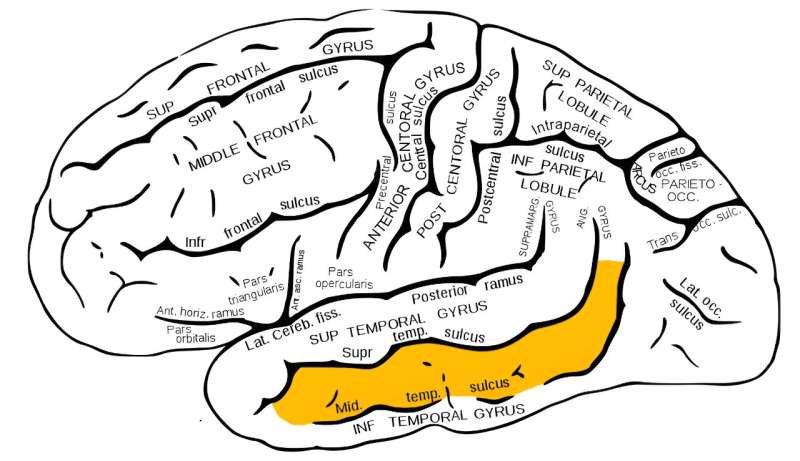
Almost nothing in the world is still. Toddlers dash across the living room. Cars zip across the street. Motion is one of the most important features in the environment; the ability to predict the movement of objects in the world is often directly related to survival—whether it’s a gazelle detecting the slow creep of a lion or a driver merging across four lanes of traffic.
Motion is so important that the primate brain evolved a dedicated system for processing visual movement, known as the middle temporal cortex, more than 50 million years ago. This region of the brain contains neurons specialized for detecting moving objects. These motion detectors compute the information needed to track objects as they continuously change their location over time, then sends signals about the moving world to other regions of the brain, such as those involved in planning muscle movements.
It’s easy to assume that you see and hear motion in a similar way. However, exactly how the brain processes auditory motion has been an open scientific question for at least 30 years. This debate centers on two ideas: One supports the existence of specialized auditory motion detectors similar to those found in visual motion, and the other suggests that people hear object motion as discrete snapshots.
As computational neuroscientists, we became curious when we noticed a blind woman confidently crossing a busy intersection. Our laboratory has spent the past 20 years examining where auditory motion is represented in the brains of blind individuals.
For sighted people, crossing a busy street based on hearing alone is an impossible task, because their brains are used to relying on vision to understand where things are. As anyone who has tried to find a beeping cellphone that’s fallen behind the sofa knows, sighted people have a very limited ability to pinpoint the location or movement of objects based on auditory information.
Yet people who become blind are able to make sense of the moving world using only sound. How do people hear motion, and how is this changed by being blind?
Crossing a busy street by sound alone
In our recently published study in the Proceedings of the National Academy of Sciences, we tackled the question of how blind people hear motion by asking a slightly different version of it: Are blind people better at perceiving auditory motion? And if so, why?
To answer this question, we used a simple task where we asked study participants to judge the direction of a sound that moved left or right. This moving sound was embedded in bursts of stationary background noise resembling radio static that were randomly positioned in space and time.
Our first question was whether blind participants would be better at the task. We measured how loud the auditory motion had to be for participants to be able to perform the task correctly 65% of the time. We found that the hearing of blind participants was no different from that of sighted participants. However, the blind participants were able to determine the direction of the auditory motion at much quieter levels than sighted participants. In other words, people who became blind early in life are better at hearing the auditory motion of objects within a noisy world.
We then examined how the noise bursts interfered with the ability to tell the direction of motion. For both sighted and blind participants, only the noise bursts at the beginning and the end of each trial had an effect on performance. These results show that people do not track objects continuously using sound: Instead they infer auditory motion from the location of sounds at their beginning and end, more consistent with the snapshot hypothesis.
Both blind and sighted people inferred movement from the start and stop of sounds. So why were blind people so much better at understanding auditory motion than sighted people?
Further analysis of the effects of background noise on the ability to track auditory motion showed that blind participants were affected only by noise bursts occurring at the same locations in space and moments in time as the onset and offset of the moving sound. This means that they were more sensitive to the beginning and end of the actual auditory motion and less susceptible to irrelevant noise bursts.
When you hear what I see
As any parent of a blind child will tell you, understanding motion is just one of the many ways that blind children learn to interact with the world using different cues and actions.
A sighted baby recognizes their parent’s face as they approach the crib, while a blind baby recognizes the sound of their footsteps. A sighted toddler looks toward the dog to attract their parent’s attention, while a blind toddler might pull their parent’s hand in the direction of the barking.
Understanding the ability of blind people to learn how to successfully interact with a world designed for the sighted provides a unique appreciation of the extraordinary flexibility of the human brain.
More information:
Woon Ju Park et al, The perception of auditory motion in sighted and early blind individuals, Proceedings of the National Academy of Sciences (2023). DOI: 10.1073/pnas.2310156120
Journal information:
Proceedings of the National Academy of Sciences
Provided by
The Conversation
This article is republished from The Conversation under a Creative Commons license. Read the original article.
Source: Read Full Article
